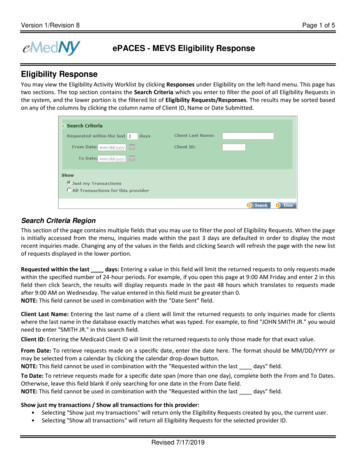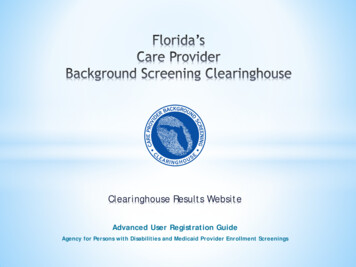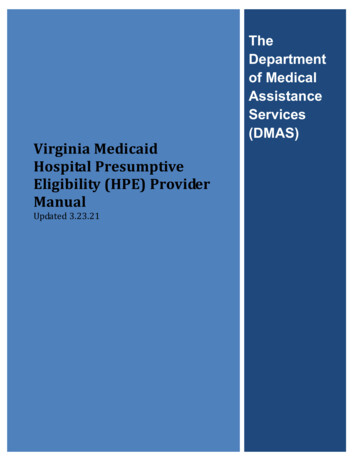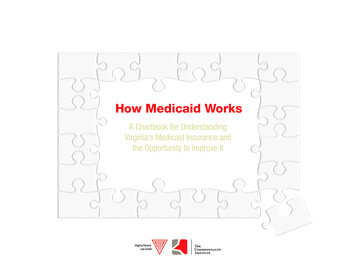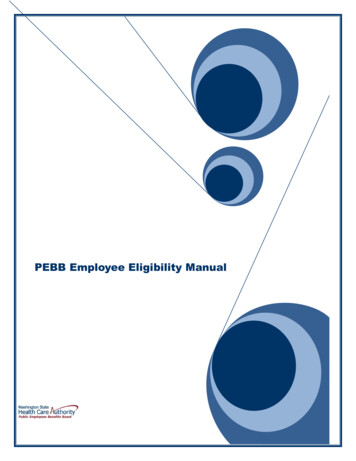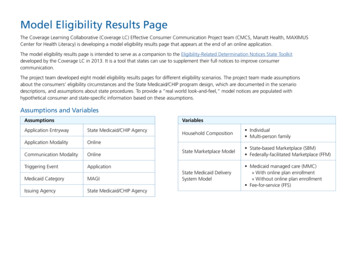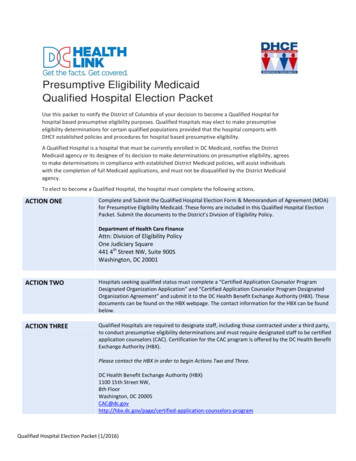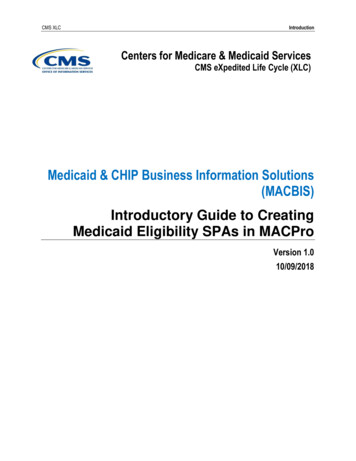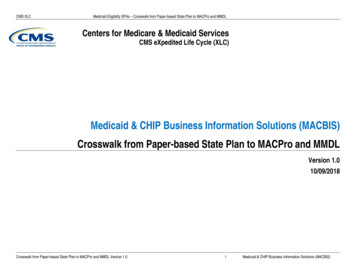
Transcription
2013 REPORT TO THE GENERAL ASSEMBLYMedicaid EligibilityInmates in Virginia’s Local and Regional Jails11/1/2013COMPENSATION BOARD with DEPARTMENT OF MEDICAL ASSISTANCE SERVICES
PrefaceThe Compensation Board is pleased to present this report providing information regardinginmates in Virginia’s local and regional jails who have incurred in-patient hospitalizations, andissues related to their potential eligibility for enrollment for coverage under Medicaid.The Compensation Board wishes to thank the Department of Medical Assistance Services fortheir significant contribution to this report in the provision of background information andanalysis regarding Medicaid coverage and application to incarcerated populations, the eligibilityand claims process management for state responsible offenders housed within the Departmentof Corrections, and analysis regarding potential issues in the application of such processes tooffenders housed in Virginia’s local and regional jails.Questions or comments regarding this report should be directed to Robyn M. de Socio,Executive Secretary for the Compensation Board, at (804) 225-3439 or via e-mail atrobyn.desocio@scb.virginia.gov. Questions related to current Medicaid policy, and eligibilityand claims processes for state responsible offenders housed within Virginia’s prison systemunder the Department of Corrections may be directed to Steven E. Ford, Deputy Director forAdministration for the Department of Medical Assistance Services, at (804) 786-7355 or via email at steve.ford@dmas.virginia.gov.Robyn M. de Socio, Executive SecretaryCompensation BoardNovember 1, 2013***********1
Authority2013 Virginia Acts of Assembly, Chapter 806, Item 69:L. The Compensation Board shall work with local and regional jails to determine the number oflocal-responsible offenders hospitalized off-site, the costs for such hospitalization, and the numbersof such hospitalized local-responsible offenders who are either 65 years of age or older, blind,disabled, or pregnant in order to determine the population of local-responsible offenders who maybe eligible for enrollment in Medicaid. The Departments of Medical Assistance Services and SocialServices shall provide any assistance necessary to the Compensation Board in determining theeligibility of those local-responsible offenders for Medicaid enrollment and the process that wouldbe necessary for localities who choose to enroll eligible local-responsible offenders in Medicaid. TheCompensation Board, with any necessary assistance from the Departments of Medical AssistanceServices and Social Services, shall provide a report on the number of local-responsible offenders whocould be enrolled in Medicaid to the Chairmen of the House Appropriations and Senate FinanceCommittees by November 1, 2013.IntroductionItem 69 L of the 2013 Appropriation Act directed the Compensation Board (hereafter, theBoard) to work with local and regional jails to determine the number and cost of localresponsible offenders hospitalized off-site who may be eligible for enrollment in Medicaid. Itfurther directed the Department of Medical Assistance Services (DMAS) and the Department ofSocial Services (DSS) to provide any assistance necessary to the Board in determining theeligibility of those offenders through the potential establishment of procedures to enrolleligible offenders in Medicaid. The Board was directed to provide a report on the number oflocal-responsible offenders who could be enrolled in Medicaid to the General Assembly byNovember 1, 2013. This document is intended to satisfy this reporting requirement.2
BackgroundUnder current Medicaid policy articulated by the federal Centers for Medicare and MedicaidServices (CMS), inmates of public institutions are categorically ineligible for coverage underMedicaid. However, CMS clarified this policy indicating that they are no longer “inmates ofpublic institutions” when they are “inpatients of medical facilities”, and therefore, federalMedicaid funding is available for the covered services provided while they are an inpatient ofthat facility.In Virginia, the normal Medicaid match rate is 50 percent, meaning for every dollar of Medicaidcost, one-half is borne by the federal government and one-half is borne by the Commonwealth.However, the Commonwealth does not provide General Funds to cover the costs of healthcareneeds of incarcerated, local-responsible offenders. Thus, the costs of needed healthcare tothese inmates in local and regional jails are borne by the localities themselves. To the extentsome local-responsible inmates can access Medicaid funding to cover their inpatienthospitalization, some of the cost of inpatient care to the localities would be eliminated throughMedicaid funding. In other words, while coverage under Medicaid for state-responsibleoffenders has the potential to be financially beneficial to the Commonwealth through thesubstitution of federal funds in place of State funds, this approach for local-responsibleoffenders would result in an added cost to the Commonwealth, with a reduction in local costs.It is important to note, as indicated above, that these costs can only be offset for inmates whoare determined to be eligible for Medicaid at the point of their inpatient hospitalization.Existing eligibility rules apply; the only special treatment, so-to-speak, is the waiving of theinmate exclusion based on the CMS policy clarification. In other words, if the individual wouldnot be eligible for coverage according to existing coverage rules were they not incarcerated,they would not be eligible when they are an inmate during an inpatient hospitalization.This is particularly important to understand in the context of inmates because existing coveragefor non-disabled adults is only available for adults living with children (caretaker adults /parents), those above age 65, or for pregnant women. While some inmates may qualify underthese non-disabled adult categories and others may have already been determined to bedisabled (and meet the other criteria for that coverage group), it is not expected that asignificant percentage of the inmate population, particularly the local-responsible offenderpopulation, will qualify for Medicaid coverage of inpatient hospital services under the currentrules.To the extent the Commonwealth decides to expand Medicaid coverage under the PatientProtection and Affordable Care Act (Pub. L. 111-148), as amended by the Health Care andEducation and Reconciliation Act of 2010 (Pub. L 111-152), such an expansion would increasethe income eligibility of the caretaker adults / parents, but more significant for the inmatepopulation, provide coverage for childless adults up to 133 percent of the federal poverty limit.Under that scenario, it is likely that a significant number of the local-responsible inmatepopulation would be eligible for Medicaid coverage of their inpatient hospitalizations.3
Eligibility ProcessDMAS, DSS and the Department of Corrections (DOC) have established a process (effective inJuly 2013) for Medicaid eligibility determination of state-responsible offenders while aninpatient of a hospital. Applications for inmates who receive inpatient hospitalization areprocessed, for the most part, using the same requirements and time standards as all otherMedicaid applicants. Eligible individuals must meet existing Medicaid criteria, but are onlyenrolled in Medicaid for the length of their inpatient hospital stay. Because of the tie-in toinpatient hospitalization, applications are filed and processed after the individual hascompleted his inpatient hospital stay.For the state-responsible offenders, centralized healthcare reimbursement staff at DOC screenthe individuals for potential Medicaid eligibility based on information contained in DOC recordsupon completion of an inpatient hospital stay. If the individual appears to meet a Medicaidcovered group, then a Medicaid application will be initiated. The application will be sent to thefacility where the inmate is housed for completion. The facility counselor reviews theapplication with the inmate, obtains any additional required information that is needed andobtains the inmate’s signature. The completed application and any supporting documentationare then sent back to the DOC healthcare reimbursement staff for submission to theappropriate local department of social services.The local department of social services will complete an eligibility determination to ensure thatall non-financial and financial criteria are met. Entitlement for Medicaid for eligible individualswill begin on the date of admission to the hospital and end on the date of discharge. Once aneligibility period is established, additional requests for coverage of inpatient services within oneyear of the date of filing of the original application will not require a new Medicaid application.However, each request for Medicaid coverage of an inpatient stay requires a review of theindividual’s financial eligibility.For the DOC inmate population, because of the centralization of inmates into a handful of largefacilities, the process can and has been targeted to a handful of local departments of socialservices in the areas associated with the large DOC facilities. This relatively centralizedapproach, however, would not be available to the extent local-responsible offenders areincluded in the policy. Since local and regional jails are spread across the Commonwealth in atleast 72 localities, it is likely that many of the 120 local departments of social services could beinvolved in this special eligibility process. Further, unlike DOC staff with access to centralizedinformation to assist in the application process, there is no such centralized data or staff toassist with the local and regional jails; information and staff utilized would, by definition, belocal.4
Claiming Process for Inpatient ReimbursementFor state-responsible offenders, DOC had already utilized a third party administrator (TPA) forthe billing and payment of healthcare claims. With this infrastructure already in place, DOC hasbeen able to leverage the TPA process to manage the billing complexities of having to sort outthe Medicaid eligibility issue while still processing provider payments. Additionally, DOC hascentralized healthcare reimbursement staff on board to work with the hospital provider in thisprocess.Once Medicaid eligibility has been established (after the inpatient stay and potentially afterinitial non-Medicaid payment has been made to the provider), the process for the hospital is: Request approval from KePRO, Medicaid’s service authorization contractorSubmit claims to Medicaid with an approved KePRO service authorizationo Option to appeal service authorization requests that result in a denial byKePROShare the approved Medicaid Offender Inpatient Referral with all physiciansrendering medical/surgical care/treatment during the offender’s inpatienthospital admissionDOC healthcare reimbursement staff provide the following claims assistance: Track the KePRO service authorization requestWith the KePRO service authorization approval, notify their TPA to retract theinitial hospital admission claims paymento Should the KePRO service authorization be denied (and upheld by anappeal), the TPA-processed initial payment will remainUtilizing the Medicaid claim subsystem, identify the Medicaid deductible and/orco-pay amounts indicated on the paid claims to determine the offenderresponsible amount for DOC reimbursement.Again, the state-responsible offender coverage procedures benefit from the centralized natureof the DOC population and the infrastructure already in place for dealing with the healthcareneeds of the incarcerated population. These functions would need to be replicated by the localand regional jails, or centralized in some manner yet to be defined.5
Offenders in Local and Regional JailsVirginia’s 65 local and regional jails house both local-responsible and state-responsible inmates.A local-responsible inmate is defined as any person arrested on a state warrant andincarcerated in a local correctional facility awaiting trial, or already sentenced but awaiting trialon a subsequent offense; any person convicted of a misdemeanor offense and sentenced to aterm in a local correctional facility; or any person convicted of a felony offense and given aneffective sentence of twelve months or less, or less than one year. A state-responsible inmateis defined as any person convicted of one or more felony offenses and the sum of consecutiveeffective sentences for felonies, committed on or after January 1, 1995, is more than 12months, or one year or more, or the sum of consecutive effective sentences for felonies,committed before January 1, 1995, is more than two years.State-responsible inmates are housed in local and regional jail facilities until such time as theyare due for transfer to a facility of the Department of Corrections. Generally speaking, a stateresponsible inmate remains housed in a jail for at least 90 days post-sentencing with all chargesadjudicated (the DOC is to bring in a state responsible inmate from the jail within 60 days afterreceiving the complete and final court order, which it should receive from the court within 30days after final sentencing), however, many state-responsible inmates remain in jail longer dueto a shortage of available space within DOC facilities. In FY12/FY13, state-responsible inmatestransferred from jail to a DOC facility had remained in jail for an average of 239 days postsentencing before being transferred. State-responsible inmates that remained in the jail for theduration of their incarceration without ever transferring to a DOC facility had remained in jailfor an average of 340 days post-sentencing before their release. During the time that a stateresponsible inmate is housed in a local or regional jail, localities remain primarily responsiblefor the cost of incurred medical expenses. Information in this report noted previously regardingeligibility determination and claims processing for state-responsible offenders for coverageunder Medicaid does not apply to the state-responsible offenders housed in Virginia’s local andregional jails.While the Appropriation Act directed the Board to report on numbers and costs for localresponsible offenders, this report does also include numbers and costs for state-responsibleoffenders who are housed in local and regional jail facilities and not in a DOC facility. Althoughapproximately 30% of the average daily population (ADP) of inmates incarcerated in local andregional jail facilities are state-responsible (8,266 SR ADP of 27,533 total ADP in FY12 & FY13),only 14% of reported in-patient hospitalizations involved state-responsible offenders (113average SR hospital commitments v. 795 average total hospital commitments in FY12 & FY13).While there are some mechanisms in place for the DOC and the Board to assist with medicalcosts incurred by localities for state-responsible offenders housed in local and regional jails, themajority of medical costs remain the responsibility of the locality, and those costs are includedin this report.6
Number of Potentially Eligible Offenders Housed in Jails and Their CostThe language in Item 69 L of the 2013 Appropriation Act directed the Board, with assistancefrom DMAS and DSS, to report on the number of offenders who could be enrolled in Medicaid.The Board maintains an inmate database in which commitment information for each offenderincarcerated in a local or regional jail is maintained, including when such offenders are in an inpatient status at a medical facility. This database includes information regarding offenders byage, which allows for an estimate of the number of aged (over 65) inmates with an inpatientstay, however, the database does not include information regarding diagnosis that wouldenable estimating incidences of pregnancy or disability. Further, payment information for inpatient services is not maintained in the Board’s database. Therefore, the Board surveyed localand regional jails to obtain additional information regarding pregnancy and disability among inpatient hospitalizations in aggregate, and also worked with Anthem, a provider of medicalinsurance for the majority of local and regional jails, to obtain hospitalization cost information.The Compensation Board collected data from its own database records regarding hospitalcommitments and age, and from jails and Anthem regarding incidences of disability, pregnancy,and hospitalization costs, for FY12 and FY13. Data collected was similar in both years, andtherefore average numbers of inmates and costs across both years are reported.This report provides actual hospitalization costs for 56 local and regional jails that utilizedAnthem’s services for hospitalization expenses in FY12 and FY13. Of the 56 jails using Anthemservices, 13 jails did not have any inmates incur in-patient hospitalization costs. A remaining 9local and regional jails in Virginia (total 65 jails) did not use Anthem’s services, and instead usedeither alternate service providers, required payment of services by the inmate or the inmate’sown health insurance (if available), had agreements with a local hospital, or the locality wasresponsible for the costs of hospitalization without a specific insurance provision. For the jailsutilizing Anthem’s services, information is available regarding inmates hospitalized and the jails’incurred costs for FY12 and FY13. For the remaining 9 jails, estimates of potential numbers ofinmates and incurred costs are determined based upon average data for the 56 jails utilizingAnthem’s services.In FY12/FY13, on average 232,427 individuals were incarcerated per year in Virginia’s local andregional jails. Of those inmates, only 1,996 (1%) were over age 65. Males comprised 183,825(79%), and the remaining 48,602 (21%) were female. Out of 56 jails with Anthem services, atotal of 344 inmates incurred expenses for in-patient hospitalizations totaling 5.14 million(note figures are per inmate, and multiple hospitalizations may have been incurred). Theaverage cost of hospitalizations per inmate was 14,968.From the listings of inmates with hospital commitments and Anthem listings of hospitalizationcosts incurred, individual jails identified 11 disabled inmates, 7 pregnant inmates, and 22inmates aged over 65. The average cost incurred for 40 inmates meeting eligibility criteria was7
580,802. Using these figures to estimate additional inmates and costs that may be incurred inthe 9 non-Anthem jails, the Board projects a potential additional 6 inmates meeting Medicaideligibility criteria at an additional cost of 95,020. Therefore, the total estimated average costper year in FY12 and FY13 is 675,822 for an estimated 46 inmates meeting the currentMedicaid eligibility criteria of over aged 65, pregnant, or disabled. While this cost wouldpresently be the responsibility of the locality, or locality participants in the case of a regionaljail, if these inmates were to be determined eligible and claims processed for Medicaid funding,one-half of this amount ( 337,911) would represent the General Fund cost to theCommonwealth (with the remainder funded by federal Medicaid funds). Note that these costsrepresent negotiated rates for services with a private carrier and coverage under Medicaidcould yield lower rates, however, the difference between the average costs per hospitalizationfrom Anthem data and average rates for state-responsible inmates in DOC facilities underMedicaid does not appear to be significant.As noted previously in the background information regarding Medicaid coverage and inmates,under a potential expansion of Medicaid coverage, it is likely that a significant number of thelocal and regional jail inmate population would be eligible for Medicaid coverage of their inpatient hospitalizations. Where in-patient hospitalization costs incurred were reported forinmates in 56 jails using Anthem services, projecting total costs for inmates in all 65 local andregional jails could indicate a potential cost of 5.97 million for approximately 399 inmates.However, given the more “short-term” nature of the local-responsible inmate population injails, where a large portion of inmates may be awaiting trial and may either maintain alternatehealth care coverage, or may maintain an income level that could preclude eligibility forMedicaid coverage, further evaluation would be required to determine the full potential impactof expansion on this population.Summary statistics and details of numbers and costs of in-patient hospitalizations in FY12 andFY13 can be found in the appendix to this report.8
Potential ChallengeAs stated throughout this document, the procedures established with DOC for the stateresponsible offender population benefit greatly from access to centralized data and staff, andexisting infrastructure with the DOC TPA, in dealing with a very tedious eligibility andreimbursement process necessitated by the CMS policy. This centralization is non-existent withthe local and regional jails in terms of how healthcare is currently delivered to jail inmatepopulations. The lack of centralization does not allow for the efficiencies and controls assumedin the state-responsible offender coverage procedures: Instead of focused training in a handful of local departments of social services who willsee volume with DOC, every local department will need to be trained despite limitedvolume from local and regional jails;Instead of focused training in a handful of corrections staff who will see volume withlocal departments, staff from every local and regional jail will need to be trained despitelimited volume;Instead of dedicated staff contacts to work with providers and DMAS on billing andpayment with regularity, each local and regional jail will need to provide this resourcewith limited regularity; and,Instead of a focused approach with a handful of hospital providers providing themajority of inpatient care to the state-responsible offender population, it is likely thatmany more Virginia hospitals would be involved, albeit at low-volume, in serving localand state-responsible offenders housed in local and regional jails.Even with the small volume expected under current Medicaid eligibility rules, the decentralizednature of the local and regional jail system could cause this process to become a workloadconcern for DMAS and DSS, particularly at the local department of social services level; to theextent Medicaid is expanded under the PPACA, this concern would grow exponentially. Equallyimportant, the approach raises concerns associated with program integrity and eligibility error.With a decentralized, low-volume approach, it is much more difficult for the staff involved todevelop the expertise and experience in dealing with this complex policy, which has thepotential to lead to errors and the misuse of Medicaid funding.9
ConclusionThe Compensation Board and the Departments of Medical Assistance Services and SocialServices have collaborated to identify the population of offenders in local and regional jailspotentially eligible for Medicaid coverage of their inpatient hospitalizations, as directed underthe 2013 Appropriation Act. Even more than the program for state-responsible offenders,applying the coverage policy to offenders at local and regional jails could present significantchallenges due to the decentralized nature of these facilities in relation to the multitude of localsocial services agencies with which they would need to work.While inmate and cost figures have been provided based upon actual in-patient hospitalizationsacross most local and regional jails, these estimates may be tenuous as they relate to thenumber of disabled inmates, given the current limited expertise within jails to identify whetherinmates that previously incurred a hospital commitment met the criteria for a DSS disabilitydesignation or are otherwise eligible for coverage under Medicaid. However, despite the lackof expertise in identifying whether a disability designation is appropriate, the low numbers ofinmates with in-patient hospitalizations meeting current Medicaid eligibility criteria is notunexpected, as alternatives to incarceration are likely employed for inmates awaiting trial thatmay be disabled, pregnant or over age 65, thus reducing the frequency of this type of offenderfrom the population in local and regional jails.Finally, the actual costs incurred (and projected for the small portion without data), while smallgiven the number of individuals that are committed and released from local and regional jailfacilities each year, are subject to change and would require additional analysis in the event ofexpansion of Medicaid coverage in Virginia.***********10
Appendix
Summary Statistics of Inmate and Hospitalization Data for FY12 and FY13Summary StatisticsFY12Number of jails in studyNumber of jails with AnthemNumber of jails with hospitalization dataTotal inmates w/hospitalizationsTotal cost hospitalizationsAverage cost hospitalization per inmateFY13655641average655645655643 3494,877,085 13,974 3395,410,925 15,961 3445,144,00514,968Number of jails without Anthem servicesEstimated other inmates w/hospitalizationsEstimated cost hospitalizations (other jails) 956783,817 954869,613 955827,513Projected total inmates w/hospitalizationsProjected total cost inmates w/hospitalizations 4055,660,902 3936,280,537 3995,971,518Hospitalized disabledHospitalized pregnantHospitalized 65 Total potential Medicaid eligiblePotential Medicaid cost151025506419291172240 698,723 462,881 580,802Number of jails without Anthem servicesEstimated other inmates medicaid eligibleEstimated potential Medicaid cost (other jails) 98112,295 9574,392 9695,020Projected potential medicaid eligible inmatesProjected potential total medicaid cost all jails 58811,017 34537,273 33Total males under 65 in jailTotal females under 65 in jailSubtotal under 65 in jailPercentage under 65 in jailTotal males 65 in jailTotal females 65 in jailSubtotal 65 in jailPercentage 65 in jailTotal males in jailTotal females in jailTotal all in jailTotal LR ADP in jailPercentage LR ADP in jailTotal SR ADP in jailPercentage SR ADP in jailTotal ADP in jailInstances of hospitalization (LIDS)Instances of hosp LR 65Instances of hosp SR 65Instances of hosp LR 65 Instances of hosp SR 65 73912221358996154664109184Percentage SR instances of hospitalizationPercentage LR instances of hospitalization14%86%14%86%14%86%Percentage 65 instances of hospitalizationPercentage 65 instances of hospitalization3%97%3%97%3%97%11Source: CB LIDS, Jail Reports, Anthem
Jail and Anthem Reports of Inmate and Hospitalization Data, 30490Jail NameACCOMACK COUNTY JAILALBEMARLE-CHARLOTTESVILLE REG.ALEXANDRIA DETENTION CENTERALLEGHANY COUNTY REGIONAL JAILARLINGTON COUNTY DETENTION FACB.R.R.J - CAMPBELLB.R.R.J. - AMHERSTB.R.R.J. - BEDFORDB.R.R.J. - HALIFAXB.R.R.J.- LYNCHBURGBOTETOURT COUNTY JAILBRISTOL CITY JAILCENTRAL VIRGINIA REGIONAL JAILCHARLOTTE COUNTY JAILCHESAPEAKE CITY JAILCHESTERFIELD COUNTY JAILCULPEPER COUNTY JAILDANVILLE CITY JAILDANVILLE CITY JAIL FARMEASTERN SHORE REGIONAL JAILFAIRFAX ADULT DETENTION CENTERFAUQUIER COUNTY JAILFRANKLIN COUNTY JAILGLOUCESTER COUNTY JAILHAMPTON CORRECTIONAL FACILITYHAMPTON ROADS REGIONAL JAILHENRICO COUNTY JAILHENRY COUNTY JAILLANCASTER CORRECTIONAL CENTERLOUDOUN COUNTY ADULT DETENTIONMARTINSVILLE CITY JAILMEHERRIN RIVER REGIONAL JAILMIDDLE PENINSULA REGIONALMIDDLE RIVER REGIONAL JAILMONTGOMERY COUNTY JAILMRRJ - MECKLENBURGNEW RIVER REGIONAL JAILNEWPORT NEWS CITY JAILNEWPORT NEWS CITY PRISON FARMNORFOLK CITY JAILNORTHERN NECK REGIONAL JAILNORTHWESTERN REGIONAL JAILPAGE COUNTY JAILPAMUNKEY REGIONAL JAILPATRICK COUNTY JAILPETERSBURG CITY JAILPEUMANSEND CREEK REGIONALJailJailFY12 NumberDisabledFY12 NumberPregnant10JailAnthemFY12 65 # Inmates 2112Average cost perPotentiallyTotal Costhospitalized inmate Medicaid EligibleHospitalizationsin 674.1011,580.005,790.00-notes:not anthemnot anthemnot anthemnot anthemnot anthem
Jail and Anthem Reports of Inmate and Hospitalization Data, 171175491183191169051185810470187620494Jail NamePIEDMONT REGIONAL JAILPITTSYLVANIA COUNTY JAILPORTSMOUTH CITY JAILPR. WILLIAM/MANASSAS REGIONALRAPPAHANNOCK COUNTY JAILRAPPAHANNOCK REGIONAL JAILRICHMOND CITY JAILRIVERSIDE REGIONAL JAILROANOKE CITY JAILROANOKE COUNTY/SALEM JAILROCKBRIDGE REGIONAL JAILROCKINGHAM-HARRISONBURG REG.SHENANDOAH COUNTY JAILSOUTHAMPTON COUNTY JAILSOUTHSIDE REGIONAL JAILSUSSEX COUNTY JAILSWVRJ - ABINGDONSWVRJ - DUFFIELDSWVRJ - HAYSISWVRJ - TAZEWELLVIRGINIA BEACH CORRECTION. CTRVIRGINIA PENINSULA REGIONALWARREN COUNTY JAILWESTERN TIDEWATER REGIONALWESTERN VIRGINIA REGIONAL JAILJailJailFY12 NumberDisabledFY12 NumberPreg
The Departments of Medical Assistance Services and Social Services shall provide any assistance necessary to the Compensation Board in determining the eligibility of those local-responsible offenders for Medicaid enrollment and the process that would be necessary for localities who choose to enroll eligible local-responsible offenders in Medicaid.
